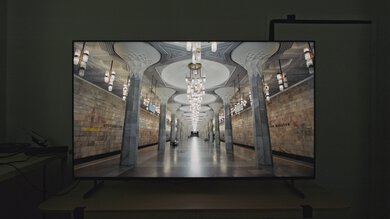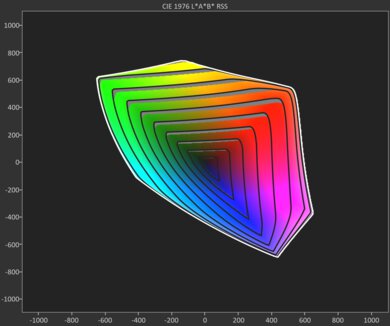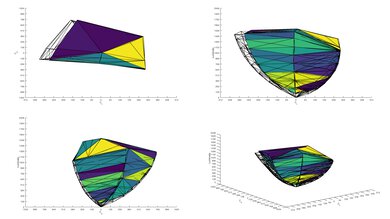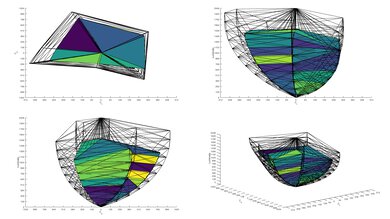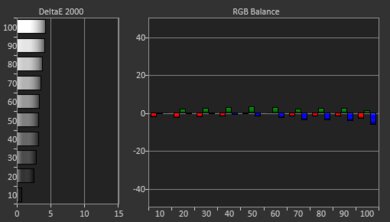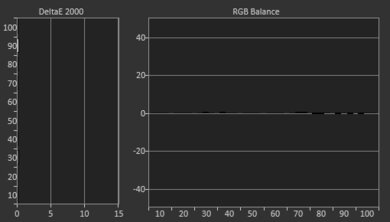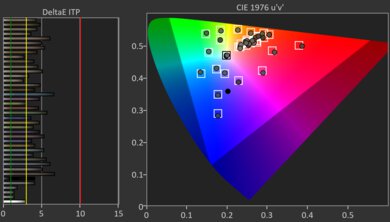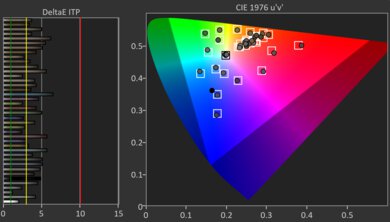The Sony X90L/X90CL is a mid-range 4k TV released in 2023. It replaces the Sony X90K/X90CK and sits above entry-level models like the Sony X85L and the Sony X77L/X77CL. Unlike the higher-end Sony X93L/X93CL, it doesn't feature a Mini LED backlight but does have a full array local dimming feature. It offers a great selection of features typically found on higher-end Sony TVs, including hands-free voice control, an S-Center speaker input, and an ATSC 3.0 tuner for up to 4k broadcast support. It's powered by Sony's Cognitive Processor XR, designed to improve overall image processing and upscaling. It also has HDMI 2.1 bandwidth and variable refresh rate (VRR) support for gamers, so you can take full advantage of the latest consoles. We bought and tested the 65-inch model, but it's available in sizes ranging from 55 inches to a massive 98-inch model, so there's something for everyone.
Our Verdict
The Sony X90L is good for mixed usage. It looks very good in a bright room due to its amazing SDR brightness, but you do want to avoid placing lights opposite the screen since it struggles with direct reflections. Despite having only adequate black levels, the TV also looks great in a room with the lights off thanks to its impressive colors, excellent accuracy, and good HDR brightness capabilities. You also get top-tier image processing that makes DVDs, cable broadcasts, and compressed streams look good, so it's a good TV for a home theater where you watch content with varying levels of image quality. It's a decent TV for gaming, mainly due to its image quality and gaming features, but its input lag is higher than similar models and its slow pixel transitions lead to blurry motion. It has a wide enough viewing angle for watching content with a small group, but the image degrades from more aggressive angles, so it's not good for large seating arrangements.
Good HDR brightness for impactful highlights.
Amazing SDR brightness helps it overcome glare from indirect lighting.
Exceptional upscaling and very good low-quality content smoothing.
Colors are vibrant, lifelike, bright, and accurate.
Struggles with reflections from direct sources of light.
Slow pixel transitions in Game Mode leads to blurry motion.
The Sony X90L is good for a home theater. Blacks are deep during dim and dark scenes, with minimal blooming around bright highlights and subtitles, so the TV looks solid in a dark room during most scenes. Unfortunately, blacks do become a bit raised during brighter scenes. However, the TV displays impressively vibrant colors that really stand out. Those colors are also very accurate in both SDR and HDR, and the brightness of HDR content is accurate too, so this is a TV that respects the filmmaker's intent. Highlights in HDR content pop out thanks to the TV's good HDR peak brightness, delivering an impactful viewing experience. You also get outstanding upscaling and great low-quality content smoothing, which ensures the image looks clean when watching low-resolution and low bitrate content.
Good HDR brightness for impactful highlights.
Exceptional upscaling and very good low-quality content smoothing.
Colors are vibrant, lifelike, bright, and accurate.
Great PQ EOTF tracking means HDR content has mostly accurate brightness.
The Sony X90L is very good for bright rooms. It has amazing SDR brightness, so it easily overcomes glare from indirect light sources. However, it struggles a lot with direct reflections; if you have a lamp or window opposite the screen, it's very noticeable and distracting. On the other hand, colors remain nice and saturated, and blacks stay deep in a room with ambient lighting, so you don't lose very much picture quality when you use the TV in a bright room, which is great.
Amazing SDR brightness helps it overcome glare from indirect lighting.
Colors are vibrant, lifelike, bright, and accurate.
Blacks stay deep in a bright room.
Struggles with reflections from direct sources of light.
The Sony X90L is very good for watching sports. It has amazing SDR brightness, so it overcomes glare from indirect sources of light. However, it really struggles with direct light sources, so you are distracted by windows or lamps placed opposite the screen. It also has mediocre gray uniformity, so you do see some dirty screen effect towards the middle of the screen when large areas of uniform colors are present. It has a mediocre viewing angle, and the image holds up from a slight angle, but it quickly degrades from more aggressive angles, so it's not the best option for larger group settings. On the other hand, this TV has vibrant and accurate colors that really pop out. You also get top-notch image processing, so low-resolution and highly compressed streams and broadcasts look clean and sharp. Finally, it has a decent response time, so fast motion is mostly free from blur in most sports.
Amazing SDR brightness helps it overcome glare from indirect lighting.
Exceptional upscaling and very good low-quality content smoothing.
Colors are vibrant, lifelike, bright, and accurate.
Struggles with reflections from direct sources of light.
Some noticeable dirty screen effect towards the center of the screen.
The Sony X90L is decent for gaming. It has good enough black levels that it looks good in a dark room, the image really pops thanks to its vibrant and accurate colors, and HDR games are impactful due to the TV's good HDR brightness. It supports 4k @ 120Hz with VRR, so it has the modern gaming features needed for the PS5 and Series X|S. However, pixels transition are quite slow on this model, so fast motion in games is blurry and lacks some clarity. The TV has low enough input lag for a responsive gaming experience, but it's higher than most other similar models, so you might want to look elsewhere if you're a competitive gamer looking for the best performance possible.
Good HDR brightness for impactful highlights.
HDMI 2.1 bandwidth, up to 4k @ 120Hz, and VRR support.
Colors are vibrant, lifelike, bright, and accurate.
Higher input lag than competing models.
Slow pixel transitions in Game Mode leads to blurry motion.
Only two HDMI 2.1 ports, one of which is also the eARC port.
The Sony X90L has very good brightness. It has amazing SDR brightness, so it easily overcomes glare from indirect sources of light. You also get good HDR brightness, so highlights stand out well in HDR content.
Good HDR brightness for impactful highlights.
Amazing SDR brightness helps it overcome glare from indirect lighting.
The Sony X90L has adequate black levels. Its local dimming feature provides deep blacks in a dark room, but those blacks do become a bit raised when bright elements are also on screen. The precision of lighting zones is good overall, but there's some subtle blooming around smaller highlights, and the blooming around subtitles is quite noticeable.
The Sony X90L has impressive colors overall. It has great HDR color volume and good SDR color volume, so you get bright and vivid colors regardless of the content. Furthermore, the accuracy of colors is excellent in SDR and outstanding in HDR, so colors stay true to the content creator's intent without needing calibration.
Colors are vibrant, lifelike, bright, and accurate.
Note:We're in the process of improving our tests related to image processing, but this score should give you a general idea of how a TV performs overall with its image processing capabilities.
The Sony X90L has great image processing overall. It upscales low-resolution content very well, and it does a very good job removing artifacts from low-bitrate content. Furthermore, there's very little banding in most color gradients, and the brightness of HDR content is very accurate except for blacks being a bit brighter than intended.
Exceptional upscaling and very good low-quality content smoothing.
Great PQ EOTF tracking means HDR content has mostly accurate brightness.
Only minor banding in some color gradients.
The Sony X90L has just okay responsiveness in Game Mode. It supports VRR for a nearly tear-free gaming experience, but its input lag is higher than competing models, so it's not the best option for PVP games. Unfortunately, the TV's pixel transitions are quite slow, so there noticeable blur behind fast motion.
HDMI 2.1 bandwidth, up to 4k @ 120Hz, and VRR support.
Higher input lag than competing models.
Slow pixel transitions in Game Mode leads to blurry motion.
Only two HDMI 2.1 ports, one of which is also the eARC port.
We're in the process of fixing the way we evaluate a TV's overall motion handling. This section is currently broken, and the score isn't indicative of how well a TV handles motion overall.
Performance Usages
Changelog
-
Updated Oct 21, 2025:
This review has been updated to Test Bench 2.1. We wrote text for the newly added Micro-Judder test, refreshed the text in the updated Judder section, and tweaked the text in the renamed Response Time Stutter section.
- Updated Oct 21, 2025: We added text to the new Micro-Judder section and refreshed the text in the updated Judder and Response Time Stutter sections after converting the review to TV 2.1.
-
Updated Jun 12, 2025:
Mentioned the newly reviewed Sony BRAVIA 5 in the HDR Brightness section.
- Updated May 08, 2025: Converted to Test Bench 2.0.1. We did this to fix an issue with our scoring in the Supported Resolutions section, since TVs with a refresh rate higher than 144Hz were being penalized for not supporting 144Hz.
Check Price
Differences Between Sizes And Variants
We bought and tested the 65-inch Sony X90L, and these results are also valid for the 55-inch, 75-inch, 85-inch, and 98-inch models. The larger sizes have more dimming zones and slightly better local dimming, so black levels should be a bit better as you go up in size.
There's also a warehouse variant of this TV, the Sony X90CL, available in 55-, 65- and 75-inch sizes. It performs the same but has a backlit remote and a longer warranty. The European versions of this TV perform the same, but you can also place the stand in a narrow position, which isn't available on the U.S. model.
| Size | Model Number | Costco Model |
|---|---|---|
| 55" | XR-55X90L | XR-55X90CL |
| 65" | XR-65X90L | XR-65X90CL |
| 75" | XR-75X90L | XR-75X90CL |
| 85" | XR-85X90L | XR-85X90CL |
| 98" | XR-98X90L | - |
Our unit was manufactured in July 2023, as you can see on the label.
Popular TV Comparisons
The Sony X90L is a good TV overall. It's very bright, has Sony's top-tier image processing, and stays true to the content creator's intent in both SDR and HDR, making it an enticing option for a home theater. Despite being a normal LED model, it provides deep enough blacks for an impactful viewing experience, with only some minor blooming. However, there's Mini LED models like the Hisense U8/U8N and the TCL QM8/QM851G QLED that display deeper blacks, are brighter, and offer better overall image quality, albeit with worse accuracy and image processing. You also get better overall gaming performance on those TVs, mostly due to their lower input lag and faster pixel transitions. Still, if you need a solid TV for your home theater or living room, the X90L is a safe bet.
See our recommendations for the best TVs for watching movies, the best smart TVs, and the best 65-inch TVs. If you'd like a new soundbar to go with a new TV, check out our picks for the best soundbars.
The Sony X90L/X90CL is better overall than the Sony BRAVIA 5. The X90L is brighter overall, providing a more impactful HDR experience and making it better suited for a well-lit room. Colors are also brighter and punchier on the X90L, and they're more accurate out of the box. On the other hand, the BRAVIA 5 has slightly better contrast, lower input lag, and less stutter, but all of these things are minor, and the X90L is the better option for almost anyone.
The Sony BRAVIA 7 is better than the Sony X90L/X90CL. The BRAVIA 7 has better contrast with an improved local dimming solution. The BRAVIA 7 is also noticeably brighter than the X90L, especially in HDR, providing more impactful highlights overall. The X90L does have a wider viewing angle, although both TVs are disappointing in that department. Still, overall, the BRAVIA 7 is the better product in almost every category.
The TCL QM7K is a bit better than the Sony X90L. The TCL has much better contrast, delivering deeper, more uniform blacks in dark scenes. The TCL also has better gaming features, including a higher peak refresh rate and a wider VRR range to reduce tearing. The Sony, on the other hand, has better image processing, and it's far more accurate in HDR out of the box. If you care most about accuracy, the Sony is the better choice.
The Sony X90L/X90CL is much better than the Sony BRAVIA 3. The X90L has a local dimming feature to improve its contrast, so blacks are much deeper and stay deep when highlights are also on screen. It's also the brighter TV overall, meaning it overcomes more glare in a bright room and provides a more impactful HDR experience. The X90L is also much better for gaming due to its HDMI 2.1 bandwidth, up to 4k @ 120Hz, VRR feature, and faster response time.

We buy and test dozens of TVs yearly, taking an objective, data-driven approach to deliver results you can trust. Our testing process is complex, with hundreds of individual tests that take over a week to complete. Most of our tests are done with specially designed test patterns that mimic real content, but we also use the same sources you have at home to ensure our results match the real-world experience. We use two main tools for our testing: a Colorimetry Research CR-100 colorimeter and a CR-250 spectroradiometer.
Test Results

The Sony X90L has good brightness in HDR, a significant improvement over the Sony X90K/X90CK. Bright highlights stand out well, and real scenes are bright and vivid. Small highlights are almost as bright as the higher-end Sony X93L, but with most real content, the X93L is brighter.
These measurements are after calibrating the HDR white point with the following settings:
- HDR Picture Mode: Custom
- Brightness: Max
- Contrast: 90
- Color Temperature: Expert 2
- HDR Tone Mapping: Gradation Preferred
- Peak Luminance: High
- Auto Local Dimming: High
Even though the Sony X90L is a model from 2023, it's actually brighter than its 2025 successor, the Sony BRAVIA 5.
Switching to Game Mode in HDR results in roughly the same peak brightness in HDR.
These measurements are after calibrating the HDR white point with the following settings:
- HDR Picture Mode: Game
- Brightness: Max
- Contrast: 90
- Color Temperature: Expert 2
- HDR Tone Mapping: Gradation Preferred
- Peak Luminance: High
- Auto Local Dimming: High
The Sony X90L has amazing peak brightness in SDR. It's bright enough to easily overcome glare even in a very bright room.
These measurements are after calibration with the following settings:
- Picture Mode: Custom
- Brightness: Max
- Contrast: 90
- Color Temperature: Expert 1
- Peak Luminance: High
- Auto Local Dimming: High
The Sony X90L has okay contrast, resulting in deep blacks during most scenes. However, black levels do raise a bit when very bright highlights are on the screen. Unlike the Sony X93L, this model doesn't have a wide viewing angle filter, so the native contrast is much higher. The full array local dimming feature is extremely effective at boosting contrast, but it isn't as good as the Mini LED backlight on the X93L.
Although the algorithms do a good job averaging out bright highlights to reduce blooming, they're not very fast and struggle to keep up with fast-moving objects. It causes the leading edge to appear dark, as the lighting zones aren't turning on quickly enough, and a longer bloom trail behind them. With slower highlights, there's noticeable flicker as they move across the screen.
The black uniformity of this TV is mediocre. With local dimming disabled, the entire screen is bluish, but there are no noticeable hot spots or backlight bleed. With local dimming enabled, black areas of the screen are much deeper, but due to the relatively large size of the dimming zones and the way the algorithms spread highlights out, there's some noticeable blooming.
The TV's SDR color volume is good overall. It has great coverage of the DCI-P3 color space, only struggling a bit with some lighter shades of color. The TV’s coverage of the wider BT.2020 color space is noticeably worse, and it struggles a lot more with all colors.
| Volume ΔE³ | DCI-P3 Coverage |
BT.2020 Coverage |
|---|---|---|
| L10 | 93.04% | 65.09% |
| L20 | 93.89% | 67.99% |
| L30 | 92.87% | 67.27% |
| L40 | 91.70% | 68.91% |
| L50 | 90.46% | 70.05% |
| L60 | 89.11% | 69.88% |
| L70 | 88.50% | 70.84% |
| L80 | 87.58% | 67.94% |
| L90 | 86.79% | 66.56% |
| L100 | 88.73% | 82.34% |
| Total | 89.46% | 69.38% |
The TV's HDR color volume is great. Dark, saturated colors look great thanks to the high contrast ratio, and bright colors are vibrant and stand out well.
With just a few settings changes out of the box, the Sony X90L has impressive SDR accuracy. There are a few slight issues with the white balance, but it's decent overall, and the colors are excellent, with no noticeable issues. The color temperature is essentially perfect, and gamma is very close to the 2.2 target used for a moderately lit room.
The TV is very easy to calibrate, and the results after calibrating it to a D65 white point are nearly perfect.
See our full calibration settings.
The Sony BRAVIA X90L has exceptional accuracy in HDR before calibration. There's some minor inaccuracies with white balance in some shades of gray, which makes the TV's color temperature a touch too cool, but it's still very close to 6500K. Color accuracy is outstanding overall, with only some very slight inaccuracies that most people won't notice. This is a TV that's incredibly accurate out-of-the-box, so calibration isn't necessary.
After calibration, the TV is a bit more accurate in HDR. White balance is a bit better now, which brings its color temperature even closer to 6500K. Color accuracy is mostly unchanged, but some of the minor mapping errors have been reduced.
This TV has impressive PQ EOTF tracking, ensuring that most HDR content is displayed at or close to the brightness level intended by the content creator. Near-black scenes are slightly raised, so some shadow details look a bit washed out.
The Sony X90L does a great job smoothing out low-quality content, but it's slightly worse than most comparable Sony TVs like the Sony X93L. Still, macro-blocking and pixelization issues are smoothed out well, and there's very little loss of fine detail.
The TV has superb sharpness processing capabilities. Low-resolution content is upscaled well, and lines are sharp with very little over-sharpening. Fine details in busy scenes are easy to make out, and hardcoded text looks great.
These results are with the following processing settings:
- Sharpness: 60
- Reality Creation: Auto
This TV has great gradient handling in HDR. There's some light banding in bright shades of blue and green, but everything else looks excellent.
This TV has very low input lag in Game Mode, ensuring a smooth and responsive gaming experience. It's worth noting that despite the TV having low enough input lag that you don't feel any major delay with your inputs while gaming, it's a bit higher than most similar models from other manufacturers.
Like the Sony X93L, this TV supports all common formats up to 120Hz. All supported formats also display chroma 4:4:4 or RGB signals properly, ensuring text is clear and easy to read when using it as a PC monitor. HDMI ports 1 and 2 are limited to HDMI 2.0 bandwidth, so they don't support 4k @ 120Hz.
The TV supports most variable refresh rate technologies, aside from FreeSync, to reduce screen tearing in games.
With the exception of 1440p, the TV is fully compatible with everything the PS5 offers, like 4k @ 120Hz, as well as HDMI Forum VRR. It also supports Auto Low Latency Mode, so you don't have to manually switch to Game Mode to get the lowest input lag.
With the exception of 1440p, the TV is fully compatible with everything the Xbox Series X|S offers, including 4k @ 120Hz, HDMI Forum VRR, and FreeSync Premium Pro. It supports Dolby Vision gaming, but only at 60Hz. It also supports Auto Low Latency Mode, so you don't have to manually switch to Game Mode to get the lowest input lag.
This TV has some response time stutter when watching 24p and 25p content that's most visible in scenes with slow panning shots. It's not quite as bad as it is on TVs with OLED panels, like the Sony A95L OLED, but it's still noticeable during certain scenes.
The Sony X90L is free from micro-judder with both 24p and 25p content if you're using the TV's native apps or an external device that can send a 24Hz or 25Hz signal, like a blu-ray player. However, there's apparent micro-judder present in 24p and 25p content when it's being sent to the TV via a 60p signal, so scenes with complex motion aren't as smooth as they should be.
The TV removes 24p judder from any source, including those that output content in 60Hz, which helps with the appearance of motion in movies and shows. It also removes 25p judder from external sources that can send a 25Hz signal, like an Apple TV. However, it doesn't completely remove 25p judder from the native apps or from 60p signals, but since frame times are fairly consistent, motion is just a bit jittery.
To remove 24p judder from 60Hz sources, Motionflow has to be enabled, with CineMotion set to 'High' and both sliders at 'Min'. This combination of settings removes judder without adding any soap opera effect.
The TV has a very good response time in the 'Custom' picture mode when watching content. Fast motion in most movies and sports has minimal motion blur behind it. However, it's slower when coming out of dark states, so there's some black smearing in dark scene transitions.
There's an optional backlight strobing feature, commonly known as black frame insertion (BFI), which you can enable to improve the appearance of motion. This TV can only flicker at 120Hz, which causes image duplication with 60 fps content. The backlight flicker pattern is very unusual, flickering at both 120Hz and an underlying 720Hz pattern, similar to the Sony X90K/X90CK.
This TV can interpolate lower-frame-rate content up to 120 fps. Sony's motion processing is generally pretty good, but like most TVs with motion interpolation at max, there are noticeable halos and artifacts around fast-moving objects.
The Sony X90L has poor direct reflection handling. It barely reduces the intensity of lamps, wall lights, or windows opposite the screen when watching content or playing video games, which is distracting.
The TV has exceptional black levels in a bright room. Black levels are barely raised in a room with ambient lighting, and they remain deep and punchy.
The Sony X90CL has very good color saturation in ambient lighting. Colors shown at all levels of luminance are still vibrant and saturated in a bright room, even after they lose some saturation from ambient sources of light.
The TV has an acceptable viewing angle. The image looks mostly consistent from a slight angle, but there's gamma shifting, the black levels raise, and there's color washout that worsens the further you move off-center. The image is noticeably degraded at an aggressive angle, so the TV isn't a very good choice for a large group setting.
Unfortunately, the gray uniformity is unremarkable on this TV. The corners are slightly darker than the center, but this isn't noticeable with most real content. The bigger issue is the noticeable dirty screen effect in the center, and there are dark vertical columns across the entire screen, which can be especially noticeable in content with large bright areas. The uniformity in near-dark scenes is much better and looks good overall.
This TV uses a BGR subpixel layout. It doesn't affect picture quality but can cause issues with text clarity in some applications when using it as a PC monitor.
The TV uses a KSF phosphor coating to produce red light, and has high peaks on reds and blues. This model does have good separation between colors, giving it solid color purity and a wide color gamut.
HDMI ports 3 and 4 support the full 48 Gbps bandwidth of HDMI 2.1, while HDMI 1 and 2 are limited to HDMI 2.0 bandwidth. However, because HDMI 3 is an HDMI 2.1 and eARC port, you lose an HDMI 2.1 slot if you connect a receiver, so you can only use HDMI 2.1 bandwidth on multiple devices simultaneously if the receiver also supports it. Also, the tuner supports ATSC 3.0, allowing you to stream over-the-air channels at up to a 4k resolution.
The TV supports eARC, which lets you pass high-quality, uncompressed audio to a compatible receiver through an HDMI cable. It supports all major audio formats, so you don't have to worry about compatibility with external sources.
The Sony BRAVIA XR X90L has diamond-shaped metal feet that hold the TV very well. The feet can be mounted either in the normal position shown above or in a raised position to leave room for a soundbar. In Europe, there's a third option to mount the feet in a narrow position, but the U.S. models don't have this option. Confusingly, the back of the TV still has arrows to indicate the narrow position, but the bottom of the TV lacks the necessary mounting points.
Footprint of the 65-inch model: 47.2" x 13.6"
With the feet mounted in the normal position, there's about 1.8" between the table and the first row of pixels. Mounting it in the raised position increases this to about 3.3", so most soundbars fit without blocking any portion of the screen.
The back of the TV is entirely plastic and has a checkerboard pattern similar to that of other Sony TVs of this generation, like the Sony X93L. One difference between the Sony X90L and higher-end models is that this model doesn't include covers to hide the inputs, and there's nothing for cable management.
The Sony BRAVIA XR X90L runs version 10 of the Google TV smart platform, similar to past Sony models like the Sony X95K.
Unfortunately, like most TVs on the market, there are ads throughout the entire Google TV interface. You can opt out of personalized ads, but this doesn't change the number of ads you'll see; they just won't be personalized to match your search and viewing history.
The included remote is small, as it doesn't have a numpad. There are mics in the remote and built into the TV, and they let you ask it to search for content, change settings, and open apps. The remote included with the Sony X90L doesn't have a backlight, but the Costco variant Sony X90CL does.
The Sony X90CL's frequency response is decent. Like most TVs, it lacks deep bass or rumble, but the sound profile is well-balanced at moderate listening levels, and dialogue sounds good. It also gets loud enough even in a moderately noisy environment.
The stand position impacts the overall sound profile, and lifting it to the raised position reduces the bass response of the TV. The low-frequency extension (LFE) in the raised position is at 119.87Hz.




